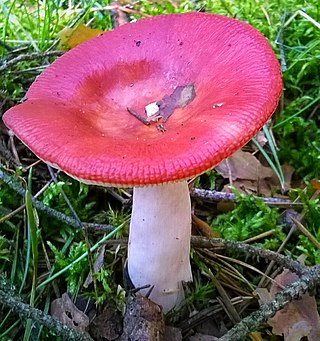
Russula emetica, commonly known as the sickener, emetic russula, or vomiting russula, is a basidiomycete mushroom, and the type species of the genus Russula. It has a red, convex to flat cap up to 8.5 cm (3.3 in) in diameter, with a cuticle that can be peeled off almost to the centre. The gills are white to pale cream, and closely spaced. A smooth white stem measures up to 10.5 cm (4.1 in) long and 2.4 cm (0.9 in) thick. First described in 1774, the mushroom has a wide distribution in the Northern Hemisphere, where it grows on the ground in damp woodlands in a mycorrhizal association with conifers, especially pine.
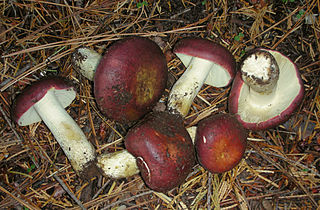
Russula xerampelina, also commonly known as the shrimp russula, crab brittlegill, or shrimp mushroom, is a basidiomycete mushroom of the brittlegill genus Russula. Two subspecies are recognised. The fruiting bodies appear in coniferous woodlands in autumn in northern Europe and North America. Their caps are coloured various shades of wine-red, purple to green. Mild tasting and edible, it is one of the most highly regarded brittlegills for the table. It is also notable for smelling of shellfish or crab when fresh.

Russula ochroleuca is a member of the genus Russula. A group that have become known as brittlegills. It has been commonly known as the common yellow russula for some years, and latterly the ochre brittlegill. It is widespread, and common in mixed woodland.

Russula virescens is a basidiomycete mushroom of the genus Russula, and is commonly known as the green-cracking russula, the quilted green russula, or the green brittlegill. It can be recognized by its distinctive pale green cap that measures up to 15 cm (6 in) in diameter, the surface of which is covered with darker green angular patches. It has crowded white gills, and a firm, white stipe that is up to 8 cm (3 in) tall and 4 cm (1.6 in) thick. Considered to be one of the best edible mushrooms of the genus Russula, it is especially popular in Spain and China. With a taste that is described variously as mild, nutty, fruity, or sweet, it is cooked by grilling, frying, sautéeing, or eaten raw. Mushrooms are rich in carbohydrates and proteins, with a low fat content.

Russula cyanoxantha, synonymous with R. xyanoxantha, commonly known as the charcoal burner or variegated russula, is a basidiomycete mushroom, distinguished from most other members of the genus Russula by the fact that its gills do not split, but are soft and flexible. It is one of the most common species of Russula in Europe.

Lactarius torminosus, commonly known as the woolly milkcap or the bearded milkcap, is a large agaric fungus. A common and widely distributed species, it is found in North Africa, northern Asia, Europe, and North America. It was first described scientifically by Jacob Christian Schäffer in 1774 as an Agaricus, and later transferred to the genus Lactarius in 1821 by Samuel Frederick Gray. A variety, L. torminosus var. nordmanensis, is known from the United States, Canada, and Switzerland. L. torminosus officially became the type species of Lactarius in 2011 after molecular studies prompted the taxonomic reshuffling of species between several Russulaceae genera.

Russula nigricans, commonly known as the blackening brittlegill or blackening russula, is a gilled mushroom found in woodland in Europe. It gains both its common and scientific name from its propensity to turn black from cutting or bruising.
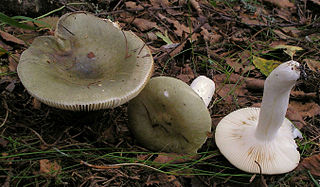
Russula aeruginea, also known as the grass-green russula, the tacky green russula, or the green russula, is an edible Russula mushroom. Widely distributed in northern temperate regions, it is usually found under birch, mostly in pine forests. The very poisonous death cap can have a similar appearance, especially from above.
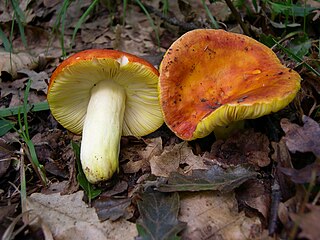
Russula aurea, commonly known as the gilded brittlegill, is an uncommon species of mushroom found in deciduous woodland in Europe in summer and early autumn. Unlike many red-capped members of the genus, it is edible and mild-tasting.

Russula delica is a mushroom that goes by the common name of milk-white brittlegill, and is a member of the genus Russula, all of which are collectively known as brittlegills. It is mostly white, with ochraceous or brownish cap markings, and a short robust stem. It is edible, but poor in taste, and grows in coniferous, broadleaved, or mixed woods. It can be confused with other white Russula species and certain white Lactarius species.

Lactarius glyciosmus, commonly known as the coconut scented milk cap, is a semi-edible mushroom in the genus Lactarius. Mycorrhizal, it can be found growing in soil at the base of birch trees in Europe. It is typically coloured a greyish lilac, with the sometimes hollow stem a little lighter coloured than the cap. It has crowded, decurrent gills, and smells strongly of coconuts.

Lactarius pallidus, the pale milkcap, is an edible mushroom of the genus Lactarius. It is pale in colour, and found on the floor in beech or birch woodland. It's smooth cap features a particularly thick layer of flesh and often has an incurved margin. Though generally considered edible, it is not recommended to be eaten raw. It is common in Europe, and less common in North America and Australasia.

Russula fragilis, commonly known as the fragile russula, or fragile brittlegill, is a species of mushroom of the genus Russula, whose members are commonly known as brittlegills. It is a small, fragile, long stemmed, and variably coloured brittlegill, found in mixed forests, and woods in Europe, Asia, and North America.
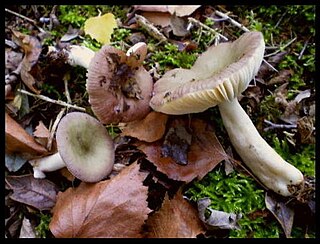
The mushroom Russula gracillima, commonly known as the slender brittlegill, is a member of the genus Russula, whose members are commonly known as brittlegills. It is a small, pale, long stemmed brittlegill associated mainly with birch and is occasional in Europe, Asia, and North America.
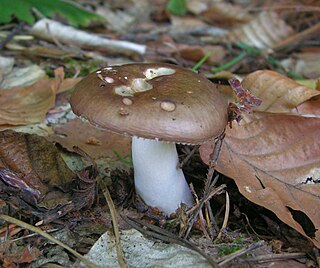
Russula integra, commonly known as the entire russula, is a species of mushroom. The fungus stems from the huge genus of Russula. It is found in conifer forests across Europe and throughout North America. The fruiting body is mildly flavoured with a slight cashew-like taste and dense flesh. It is edible and most commonly consumed in Central Europe.
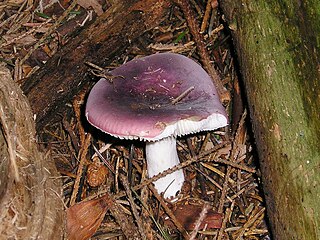
Russula turci is a common, edible, Russula mushroom, found under pines and spruces, on sandy soil and clay.
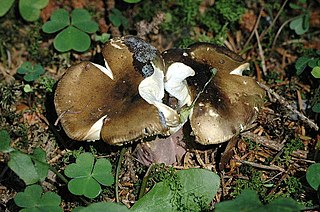
Russula olivacea is an edible and non-poisonous Russula mushroom found mostly in groups from June in deciduous and coniferous forests, mainly under spruce and beech; not rare.
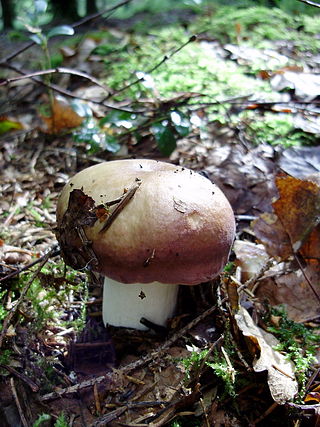
Russula decolorans, commonly known as the graying russula, is an edible Russula mushroom found in groups in coniferous forests.

Russula paludosa is an edible species of mushroom within the large genus Russula. It is common to Europe and North America.

Russula lutea is a common, edible species of mushroom in the genus Russula found throughout the Americas and Europe under broad-leaved trees from summer to early autumn.




















